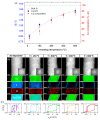Writing 3D Nanomagnets Using Focused Electron Beams
- PMID: 32859076
- PMCID: PMC7503546
- DOI: 10.3390/ma13173774
Writing 3D Nanomagnets Using Focused Electron Beams
Abstract
Focused electron beam induced deposition (FEBID) is a direct-write nanofabrication technique able to pattern three-dimensional magnetic nanostructures at resolutions comparable to the characteristic magnetic length scales. FEBID is thus a powerful tool for 3D nanomagnetism which enables unique fundamental studies involving complex 3D geometries, as well as nano-prototyping and specialized applications compatible with low throughputs. In this focused review, we discuss recent developments of this technique for applications in 3D nanomagnetism, namely the substantial progress on FEBID computational methods, and new routes followed to tune the magnetic properties of ferromagnetic FEBID materials. We also review a selection of recent works involving FEBID 3D nanostructures in areas such as scanning probe microscopy sensing, magnetic frustration phenomena, curvilinear magnetism, magnonics and fluxonics, offering a wide perspective of the important role FEBID is likely to have in the coming years in the study of new phenomena involving 3D magnetic nanostructures.
Keywords: 3D printing; additive manufacturing; focused electron beam; lithography; magnetic nanowires; nanofabrication; nanomagnetism; spintronics.
Conflict of interest statement
The authors declare no conflict of interest.
Figures









References
-
- Fert A., Campbell I.A. Transport Properties of Ferromagnetic Transition Metals. J. Phys. Colloq. 1971;32:C1-46–C1-50. doi: 10.1051/jphyscol:1971109. - DOI
-
- Beach G.S.D., Tsoi M., Erskine J.L. Current-induced domain wall motion. J. Magn. Magn. Mater. 2008;320:1272–1281. doi: 10.1016/j.jmmm.2007.12.021. - DOI
Publication types
Grants and funding
- EP/M008517/1/Engineering and Physical Sciences Research Council
- Advanced Research Fellowship/Winton Programme for the Physics of Sustainability
- EP/L015978/1/EPSRC Cambridge NanoDTC
- University of Cambridge/St. Johns College
- MAT2017-82970-C2-1-R, MAT2017-82970-C2-2-R, RED2018-102627-T/Ministerio de Economía, Industria y Competitividad, Gobierno de España
LinkOut - more resources
Full Text Sources

